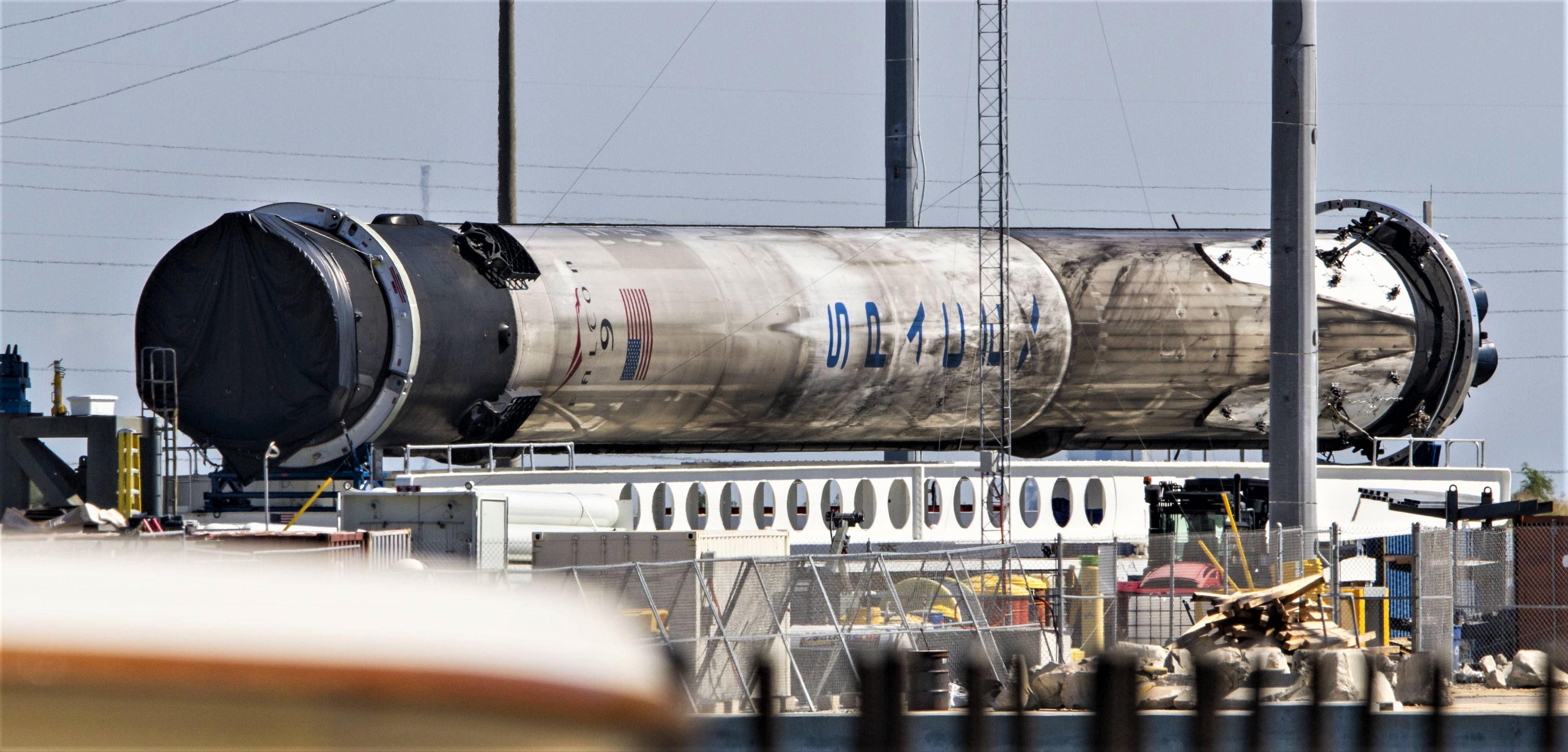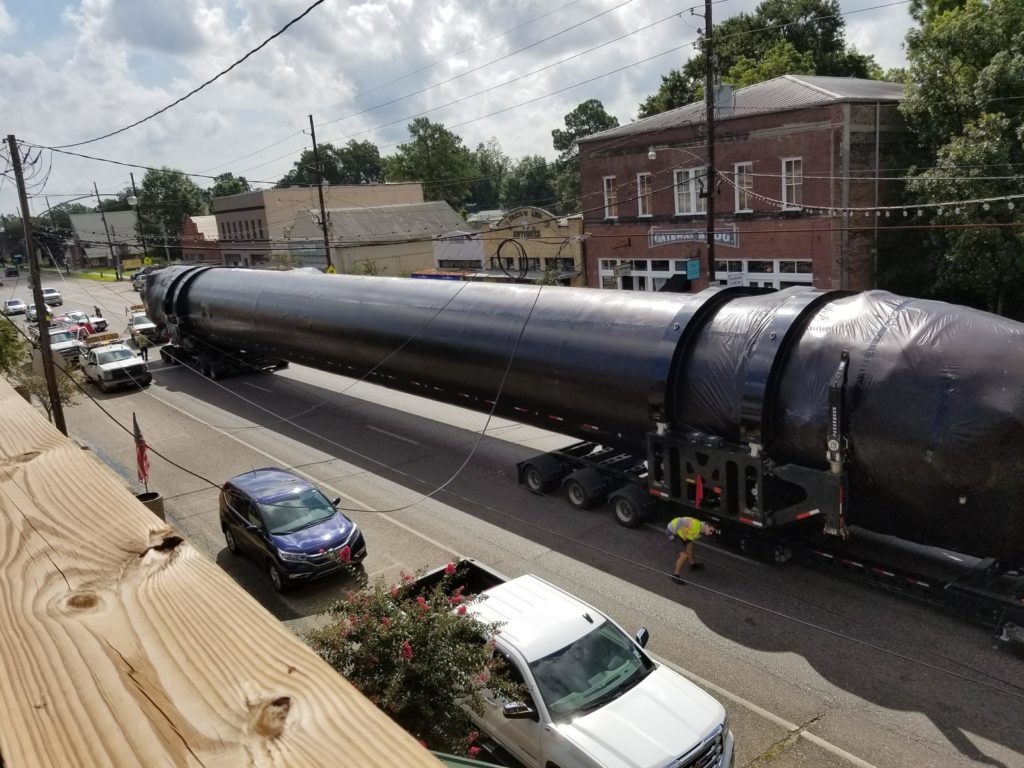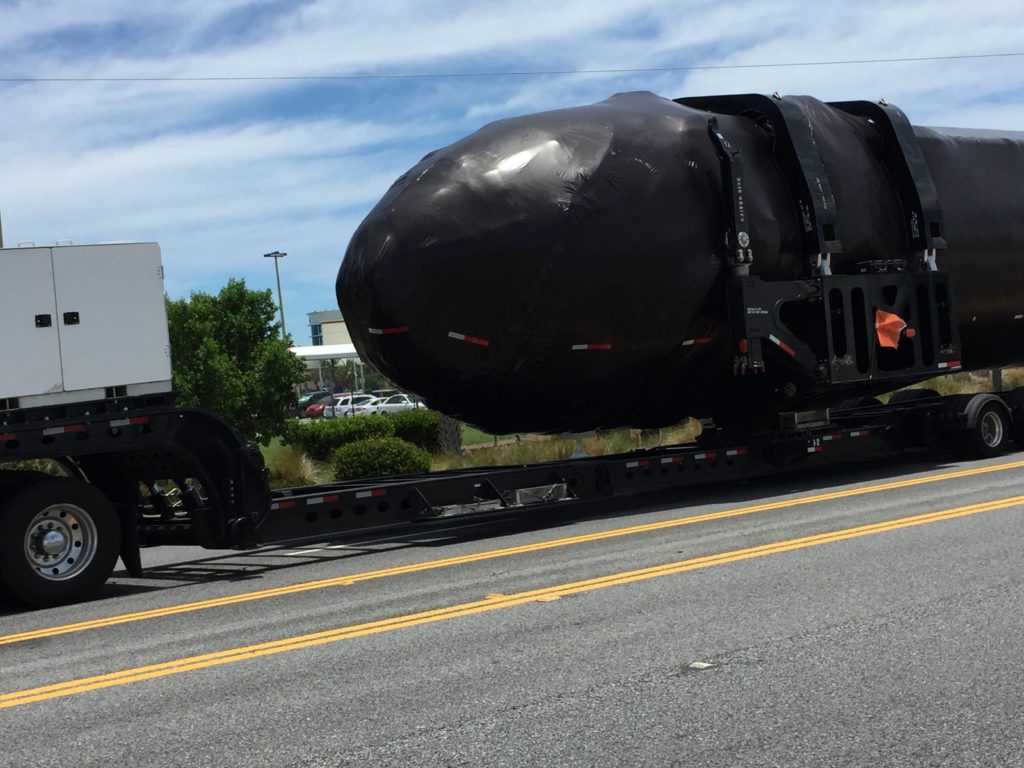News
[Update: old photo, not hardware for a new Falcon Heavy] SpaceX’s next Falcon Heavy launch gets closer to reality
Update: The photo of a Falcon Heavy nosecone posted on Instagram on August 30th was actually more than 12 months old, dating back to early preparations for the rocket’s inaugural February 2018 launch. As such, no new hardware has actually been spied arriving in Florida for Falcon Heavy’s second launch, likely sometime in early 2019.
SpaceX’s second-ever Falcon Heavy rocket appears to be entering into the (very) early stages of hardware preparation and integration in anticipation of its second launch, expected to occur as early as December 2018 or January 2019.
The apparent arrival of one of the new rocket’s side booster nosecones at Kennedy Space Center – captured by local NASA engineer Hampton Black (Instagram: @spacecoast_hampton) – is a strong indicator that SpaceX is already gearing up for the production and launch of the next serial Falcon Heavy, this time composed entirely of upgraded Block 5 boosters.
https://www.instagram.com/p/BnGz9UiHbNl/?taken-by=spacecoast_hampton
Of note, the individual transport of a Falcon Heavy nosecone to Kennedy Space Center bucks the trend observed during the transport of the first rocket’s two side boosters, both of which were shipped to Florida with nosecones already installed. Why might SpaceX be shipping a new Falcon Heavy nosecone to Florida separately, rather than atop a Falcon booster? The most obvious explanation happens to be that SpaceX is planning on reusing a flight-proven Falcon 9 Block 5 booster for Falcon Heavy’s next launch, perhaps even a booster already residing in Florida (B1047, B1049, and potentially B1051).
This should come as no surprise at all, given the inherent disruption any dedicated Falcon Heavy booster production – 3X the effort for one launch – would have on single-booster Falcon 9 manufacturing. Thanks to the extraordinary loads placed on FH center boosters, those will likely need to have a separate design dedicated to Falcon Heavy, but statements from CEO Elon Musk after the rocket’s successful February 2018 debut indicate that Falcon 9 Block 5 boosters will be interchangeable as side booster with minimal rework.
- Falcon Heavy’s refurbished side core, spotted 8/21/17 in Louisiana by an observant fan. (reddit /u/neauxgeaux)
- One of Falcon Heavy’s side boosters seen arriving at LC-39A about a month ago. (Reddit /u/MajorRocketScience)
- A Falcon Heavy side booster and its nosecone. (Tom Cross)
Inter-booster connection hardware will certainly need to be installed on the outside of any Falcon Heavy-focused Falcon 9 booster, but the only other major hardware modification apparently needed would be the replacement of a booster’s Falcon 9 interstage (wrapped in a black heat-resistant material on Block 5 vehicles) with a Falcon Heavy nosecone.
This is likely why a lone nosecone has been transported to the Cape – it might seem rather premature with Falcon Heavy’s next launch potentially five or more months away, but it’s likely that SpaceX integration engineers and technicians want to physically verify that new procedures work as expect and that the new hardware fit meets SpaceX’s tolerances. Normally, the vast majority of that final integration and verification work would be conducted in situ at the company’s Hawthorne factory, where the Falcon 9 or Heavy booster simply would not ship to McGregor or a launch pad until everything checked out as expected.

It’s entirely possible that this very booster – Falcon 9 B1046 – could be modified for duty as a Falcon Heavy side booster in the near future. August 2018. (Tom Cross)
Rather than shipping a flight-proven Block 5 booster back to Hawthorne or McGregor, SpaceX might instead be able to much more easily ship just the components that need to be swapped out in order to modify a Falcon 9 booster for Falcon Heavy side core duties. If that can, in fact, be done, it should serve to dramatically lower the previously massive work-hour gaps between Falcon Heavy and Falcon 9 launches, potentially making Heavy a much more viable and workhorse-esque rocket for SpaceX and the company’s present and prospective customers.
For prompt updates, on-the-ground perspectives, and unique glimpses of SpaceX’s rocket recovery fleet check out our brand new LaunchPad and LandingZone newsletters!

Elon Musk
Starlink achieves major milestones in 2025 progress report
Starlink wrapped up 2025 with impressive growth, adding more than 4.6 million new active customers and expanding service to 35 additional countries, territories, and markets.

Starlink wrapped up 2025 with impressive growth, adding more than 4.6 million new active customers and expanding service to 35 additional countries, territories, and markets. The company also completed deployment of its first-generation Direct to Cell constellation, launching over 650 satellites in just 18 months to enable cellular connectivity.
SpaceX highlighted Starlink’s impressive 2025 progress in an extensive report.
Key achievements from Starlink’s 2025 Progress
Starlink connected over 4.6 million new customers with high-speed internet while bringing service to 35 more regions worldwide in 2025. Starlink is now connecting 9.2 million people worldwide. The service achieved this just weeks after hitting its 8 million customer milestone.
Starlink is now available in 155 markets, including areas that are unreachable by traditional ISPs. As per SpaceX, Starlink has also provided over 21 million airline passengers and 20 million cruise passengers with reliable high-speed internet connectivity during their travels.
Starlink Direct to Cell
Starlink’s Direct to Cell constellation, more than 650 satellites strong, has already connected over 12 million people at least once, marking a breakthrough in global mobile coverage.
Starlink Direct to Cell is currently rolled out to 22 countries and 6 continents, with over 6 million monthly customers. Starlink Direct to Cell also has 27 MNO partners to date.
“This year, SpaceX completed deployment of the first generation of the Starlink Direct to Cell constellation, with more than 650 satellites launched to low-Earth orbit in just 18 months. Starlink Direct to Cell has connected more than 12 million people, and counting, at least once, providing life-saving connectivity when people need it most,” SpaceX wrote.
News
Tesla Giga Nevada celebrates production of 6 millionth drive unit
To celebrate the milestone, the Giga Nevada team gathered for a celebratory group photo.

Tesla’s Giga Nevada has reached an impressive milestone, producing its 6 millionth drive unit as 2925 came to a close.
To celebrate the milestone, the Giga Nevada team gathered for a celebratory group photo.
6 million drive units
The achievement was shared by the official Tesla Manufacturing account on social media platform X. “Congratulations to the Giga Nevada team for producing their 6 millionth Drive Unit!” Tesla wrote.
The photo showed numerous factory workers assembled on the production floor, proudly holding golden balloons that spelled out “6000000″ in front of drive unit assembly stations. Elon Musk gave credit to the Giga Nevada team, writing, “Congrats on 6M drive units!” in a post on X.
Giga Nevada’s essential role
Giga Nevada produces drive units, battery packs, and energy products. The facility has been a cornerstone of Tesla’s scaling since opening, and it was the crucial facility that ultimately enabled Tesla to ramp the Model 3 and Model Y. Even today, it serves as Tesla’s core hub for battery and drivetrain components for vehicles that are produced in the United States.
Giga Nevada is expected to support Tesla’s ambitious 2026 targets, including the launch of vehicles like the Tesla Semi and the Cybercab. Tesla will have a very busy 2026, and based on Giga Nevada’s activities so far, it appears that the facility will be equally busy as well.
News
Tesla Supercharger network delivers record 6.7 TWh in 2025
The network now exceeds 75,000 stalls globally, and it supports even non-Tesla vehicles across several key markets.

Tesla’s Supercharger Network had its biggest year ever in 2025, delivering a record 6.7 TWh of electricity to vehicles worldwide.
To celebrate its busy year, the official @TeslaCharging account shared an infographic showing the Supercharger Network’s growth from near-zero in 2012 to this year’s impressive milestone.
Record 6.7 TWh delivered in 2025
The bar chart shows steady Supercharger energy delivery increases since 2012. Based on the graphic, the Supercharger Network started small in the mid-2010s and accelerated sharply after 2019, when the Model 3 was going mainstream.
Each year from 2020 onward showed significantly more energy delivery, with 2025’s four quarters combining for the highest total yet at 6.7 TWh.
This energy powered millions of charging sessions across Tesla’s growing fleet of vehicles worldwide. The network now exceeds 75,000 stalls globally, and it supports even non-Tesla vehicles across several key markets. This makes the Supercharger Network loved not just by Tesla owners but EV drivers as a whole.
Resilience after Supercharger team changes
2025’s record energy delivery comes despite earlier 2024 layoffs on the Supercharger team, which sparked concerns about the system’s expansion pace. Max de Zegher, Tesla Director of Charging North America, also highlighted that “Outside China, Superchargers delivered more energy than all other fast chargers combined.”
Longtime Tesla owner and FSD tester Whole Mars Catalog noted the achievement as proof of continued momentum post-layoffs. At the time of the Supercharger team’s layoffs in 2024, numerous critics were claiming that Elon Musk was halting the network’s expansion altogether, and that the team only remained because the adults in the room convinced the juvenile CEO to relent.
Such a scenario, at least based on the graphic posted by the Tesla Charging team on X, seems highly implausible.











